Location
Our Idaho Location
Located in Boise, Idaho, Northpoint Recovery is proud to offer quality drug and alcohol detox as well as alcohol and drug rehab in the Treasure Valley.
- Idaho
2335 E. State Ave,
Meridian, ID 83642
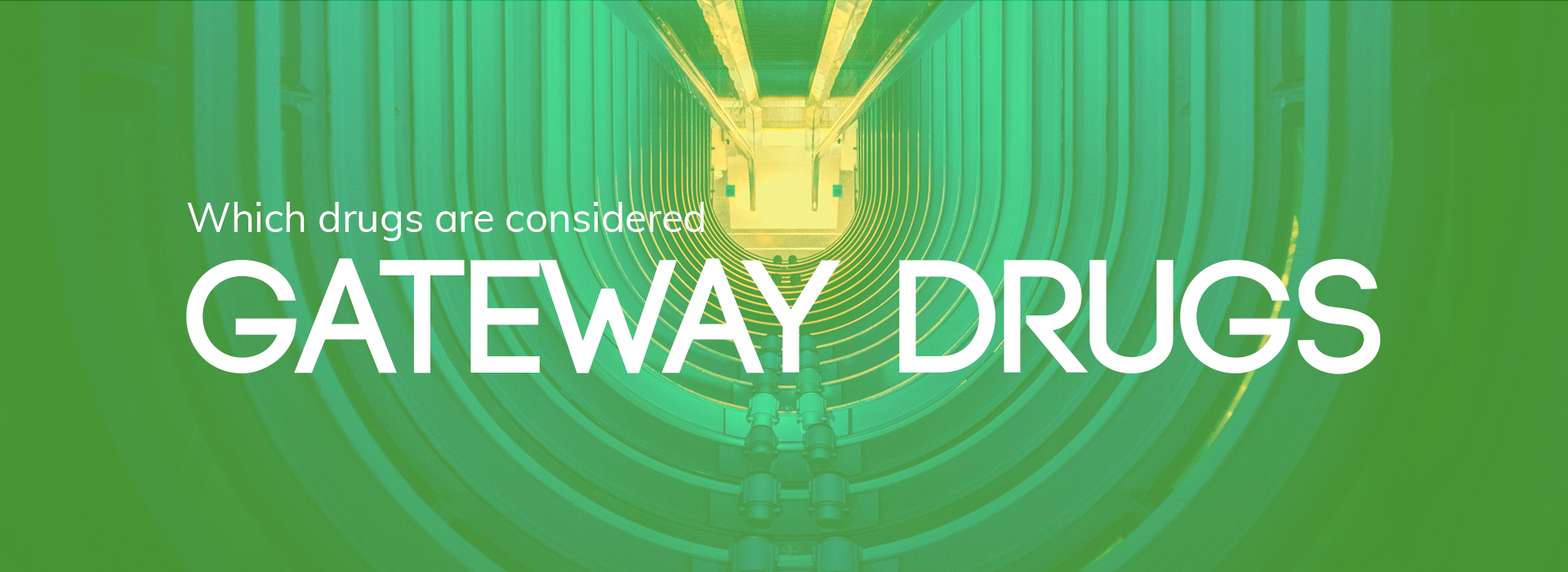
You may have heard the term gateway drugs, but not really understood what it meant. If you’re new to addiction, this term might be confusing. However, it’s actually been in use for a long time.
Once you understand what it means, you’ll have a much better understanding of how addiction often progresses. Many celebrities who have battled drug addictions started by using a gateway drug first.
Just because you use one of these substances, you aren’t necessarily destined to move on to harder drugs. It can happen, and for many people it will. However, you can take the proper steps right now to change the course of your life.
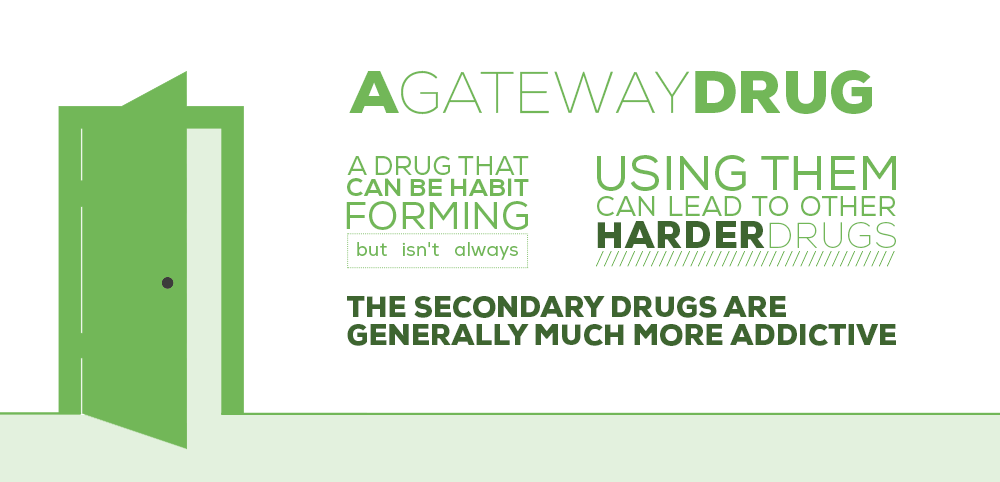
A gateway drug is a substance that can be habit forming. However, this isn’t true for all of them. Using them can lead to the use of other, harder substances. The secondary drugs are generally much more addictive.
There is a belief that using less addictive drugs can easily lead to using harder drugs. Many young people begin abusing substances this way. What they’re using seems fairly mild, and even “safe” in their eyes. What they usually don't realize is that most users will eventually develop a tolerance to them. When this occurs, people usually go searching for something stronger.
The gateway drug theory may also be called the escalation hypothesis, the progression hypothesis or the stepping-stone theory. It has become a catchphrase within the medical community regarding the use of psychoactive drugs. The theory states that any use of these substances carries a high probability for more drug use in the future.
The idea that addiction takes place in stages is one that dates back to the mid-20th century. During that time, it was hypothesized that using less dangerous drugs can result in the use of more dangerous ones. For instance, one television show called, “The Terrible Truth” suggested that there could be a link between marijuana use and later heroin addiction. By the 1980s researchers had started to use the term gateway drugs to describe substances that had that distinction.
Scientists have based this theory on the trends they’ve noticed developing in drug users. For example, among a sample of more than 6,000 people who used cannabis, the probability of the later use of harder drugs was more than 44%.
There are other factors that may also come into play when people use gateway drugs. These include:
Below is a great video that explains the gateway drug theory in even more detail:
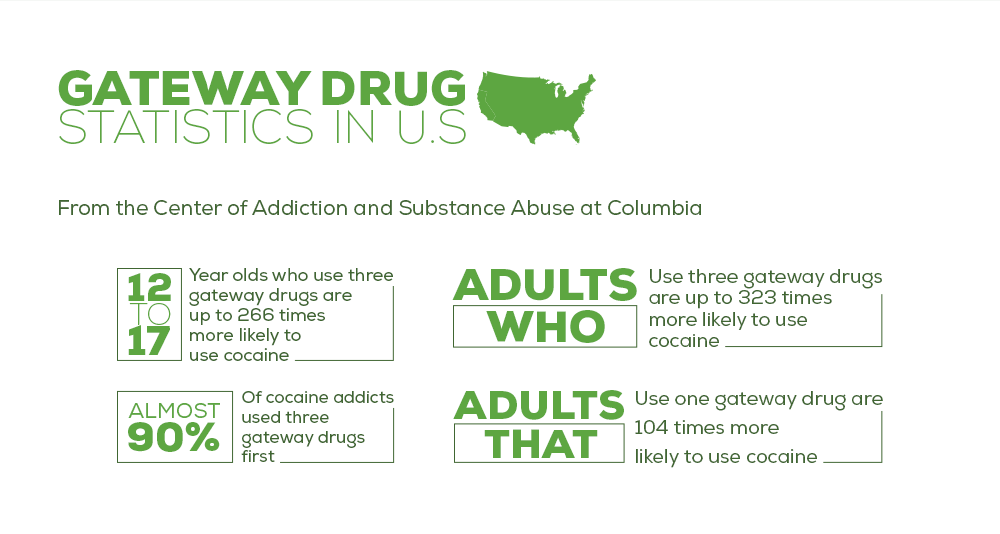
The Center of Addiction and Substance Abuse at Columbia (CASA) has released many statistics regarding gateway drugs. They indicate that:
There is a clear procession of addiction in place here. It seems that nicotine, alcohol and marijuana are leading the way to the use of harder drugs.
People who grew up in the 1980s were very well versed in the doctrine behind the D.A.R.E. Program. Nancy Reagan, who was the First Lady at that time, spearheaded the campaign. Her slogan was, Just Say No, and it was one that every elementary school child heard almost every day. The program taught children that the use of drugs like marijuana would definitely lead to the use of harder drugs, eventually.
Today, scientists are still debating whether or not the gateway drug theory holds any weight. Many claim that the use of some types of drugs actually keeps people from trying harder ones. Eventually, people involved with the D.A.R.E. Program even admitted that this could be the case.
Even so, the theory may be making a comeback in recent years. The legalization of marijuana and the heavy use of opioid drugs has people questioning the root cause of addiction.
One study that was published from Columbia University showed some interesting information about rats exposed to alcohol. They found that those rats were much more likely to press a lever that released cocaine than those that weren’t exposed. They also found that the alcohol was able to suppress two different genes that usually act as “cutoff switches” for the effects of cocaine. This worked to create a more permissive environment in the rats’ brains.
Other studies that have been done have led scientists to a very interesting conclusion. Dr. Kandel, who is a professor of sociology at Columbia University stated, “Now that we’ve done the animal experiment, we see that using one drug changes your brain in such a way that using another drug becomes more rewarding. And there is an order.”
When rats were exposed to cocaine first, using it didn’t automatically cause them to press the lever for alcohol. This indicates that the less dangerous drug, indeed, led them to have a desire for the more dangerous one.
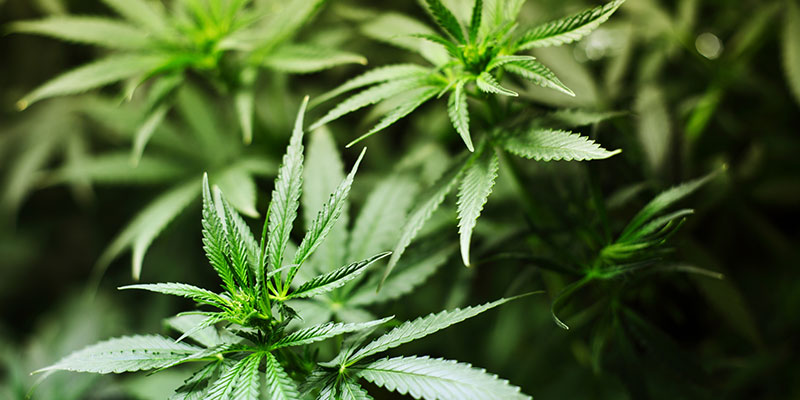
There are a number of different drugs that are considered to be gateway drugs. These include the following:
For many young people, nicotine is the first drug they try. Smoking cigarettes is common among youth, and it's a practice that many continue into adulthood.
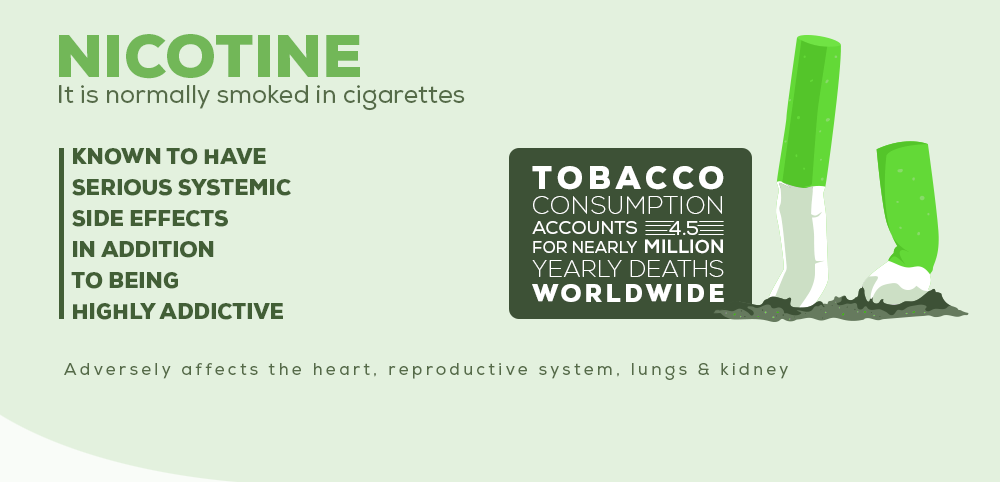
Nicotine has been considered a gateway drug for a long time. There is evidence to suggest that smoking cigarettes, or even using electronic cigarettes can lead to harder drug use.
In one study that was done in 2011, scientists gave water containing nicotine to rats. They did this for seven days in a row. Once the seven days were over, they found that the rats had an increased response to cocaine. They also learned that nicotine results in higher levels of FosB. This is a gene in the brain that is linked with cocaine addiction. They concluded that it makes sense to expect similar results in humans. In fact, they found that children who smoke could be even more at risk.
Alcohol is another popular gateway drug among both young people and adults. It suppresses the central nervous system and impairs brain function.
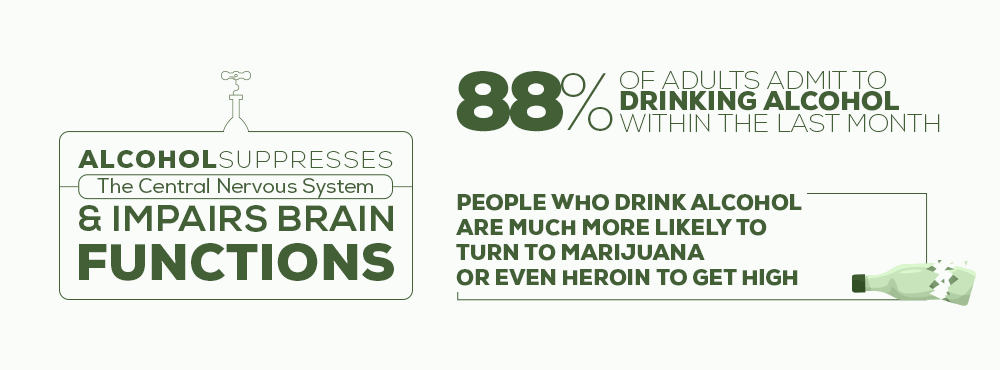
As many as 88% of adults admit to drinking alcohol at some point within the last month. In addition, 25% of adults have reported binge drinking within the last month. Many of these individuals have actual alcohol addictions. People who drink alcohol are much more likely to turn to marijuana or even heroin to get high.
One study done by the University of Florida showed that alcohol is the drug that leads people down the path to harder substances. Researchers collected data from more than 14,000 high school seniors in the United States. It was discovered that most of the students tried alcohol before they tried any other substance that was suggested. More than 72% of them reported consuming alcohol at some point in their lifetimes.
The use of drugs typically begins with the most socially acceptable ones first. That is what primarily leads people to drink. Researcher Adam Barry advises parents, “Parent should know that a strict, zero-tolerance policy at home is best. Increasing alcohol-specific rules and decreasing availability will help prevent an adolescent’s alcohol use. The longer that alcohol initiation is delayed, the more likely that other drug or substance use will be delayed or prevented as well.”
Prescription opioid use is on the rise in the United States. Many of the people who are addicted to painkillers became addicted by accident. It is a widely known fact that the use of these drugs can lead to heroin addiction. While it is acceptable to use them appropriately, this can still lead to addictions.
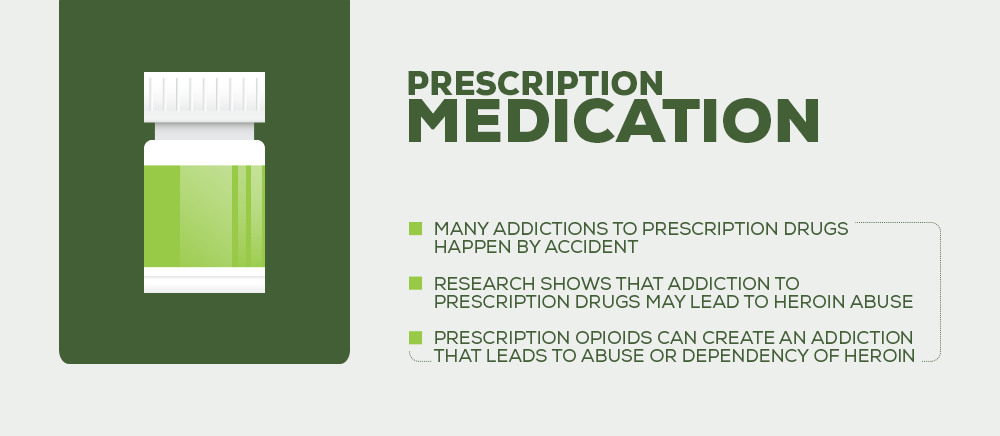
According to the National Institute on Drug Abuse, the misuse of opioids has never been a more serious problem than it is right now. In fact, they state that about 54 million people over the age of 12 have used them non-medically in the United States.
The CDC states that people who use opioid drugs are about 40 more times likely to abuse heroin. Many people who abuse these substances will eventually switch to heroin because it costs less. It’s also easier to get and use long-term.
The use of marijuana in the United States has increased substantially. In 2014, more than 22 million people reported having used it during the last month. This makes it one of the most popular among all the gateway drugs.
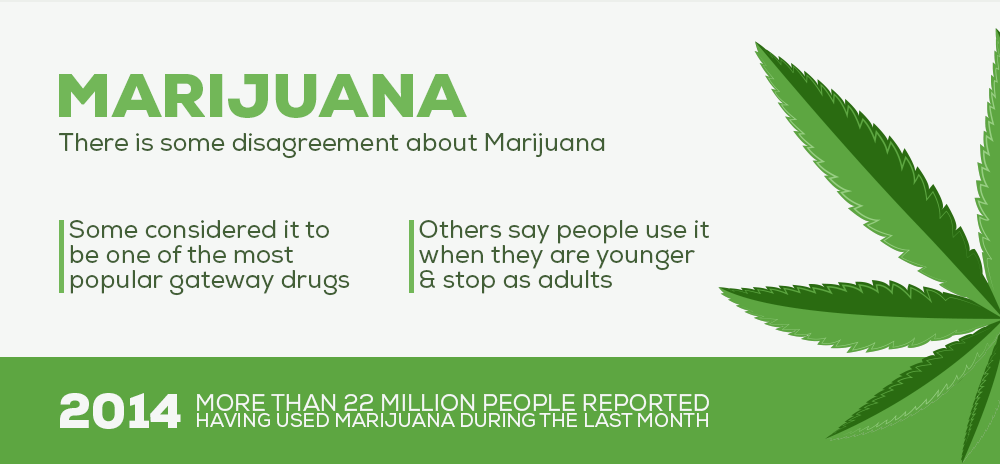
Many researchers are against naming marijuana as a gateway drug. They claim that most people use when they are young, and then stop using in adulthood. This fact is highly debated. The fact remains that many people who use cannabis will go on to use harder drugs later in life.
Medical professionals themselves often have mixed opinions about whether or not marijuana should be called a gateway drug. Here, doctors share their views:
It’s believed that marijuana can build a person’s tolerance to more potent drugs. There have been many studies done that support this belief. Interestingly enough, it’s also been found that using cannabis is linked with the use of alcohol and cigarettes as well.
Several states have legalized marijuana. This increases its availability and people have become more accepting of it. People who are against its legalization cite that the risk for eventually turning to other drugs is just too high.
It might not be a substance you’d expect to see on this list, but many experts believe that caffeine is a gateway drug to cocaine. It is the most commonly abused stimulant, and almost everyone uses it. Whether it comes in the form of coffee, soda or energy drinks, its use is prevalent in our country.
Just like other drugs, caffeine is directly linked to the activity of dopamine in the brain. Drinking it will produce a mild euphoria, which in turn, encourages the brain to crave more. In younger people, it produces a more dramatic effect. It works by increasing motor activity in adolescents.
Studies have shown that when young people are exposed to coffee, it heightens their sensitivity to cocaine-induced euphoria. Drinking caffeine can alter the brain’s neurochemistry significantly. As an adult, this means that response to cocaine is enhanced.
Surprisingly enough, certain types of foods can become gateway drugs themselves. Many of them have addictive properties, and the way they act in the body is similar to how drugs behave.
Dr. Anca Lamse frequently writes about women’s issues for the website, Women’s Lifelink. She relates a personal story about how food can easily turn into an addiction:
“My husband and I eat well (lots of veggies; fruits; fresh, unprocessed foods), practice relaxation techniques, and overall do what we can to keep our bodies healthy. And we enjoy this lifestyle. The other weekend, however, we found ourselves at the grocery store and decided to ‘treat ourselves.’ We had not had dry cereal in six months or longer, and we were craving it.
“Little did we know that titillating our taste buds would lead to cravings for more luscious foods. Since then, we’ve had a fair amount of chocolate, more bread than usual, and regular servings of crackers with peanut butter and honey. My husband called the cereal a gateway drug.”
Food addiction is very real, but can it lead to drug addiction? Many experts believe that it can. They also believe that many of the same treatment methods should be used for people who are addicted to food. You can learn more here:
Amphetamine is a medication that some doctors believe to be the ultimate gateway drug. Drugs like Adderall are extremely addictive. It often causes a lot of physical and psychological damage within those who abuse it. Not only that, but it frequently paves the way for other drugs, such as cocaine, meth and heroin.
Once someone is addicted to amphetamine, they’ll go to any lengths to get their hands on it. They may go doctor shopping in an attempt to get more prescriptions for the pills. They may lie about losing a prescription so that they can get another one. Many addicts will purchase it illegally on the street or from their friends.
Eventually, one of two scenarios will occur. The addict might not be able to get enough prescriptions for the amphetamine. When this happens, they may turn to harder drugs to get high. It’s also possible for people to form a high tolerance to a drug like Adderall. When that happens, their logical conclusion is often to opt for methamphetamine or cocaine.
Inhalants are very popular among teenagers, and even children in some cases. This type of drug involves several different substances, including:
One study collected data from more than 7,000 young people between the ages of 12 and 17 over the course of 10 years. They found that the average age in which kids start abusing inhalants is about 14. They also found that they were likely to begin using marijuana roughly half a year later.
Further research indicates that for many teens, inhalant use begins to drop off once they enter the eighth grade. Researchers drew the conclusion that it was at that point that they started seeking out other ways to get high.
Ecstasy is a very popular drug within the rave culture in the United States. Many people think of it as one of the harder drugs in our country. However, there are studies that suggest that it can actually be a gateway drug.
In one study, surveys were conducted with more than 250 young adult users of this drug in Georgia. They found that the age of onset ecstasy use correlates with the start of cocaine and meth use.
People often assume that this drug is primarily non-addictive. It’s a party drug that people only use occasionally. However, the fact remains that it can open the door to the use of other substances.
It might surprise you to learn that taking anabolic steroids can eventually lead to an opioid addiction. However, according to the New England Journal of Medicine, it’s been proven.
In a study of 227 men being treated for opioid addiction, 21 of them had a history of steroid abuse. However, only 1 man being treated for steroid addiction admitted to a history of abusing opioid drugs.
None of the men who were questioned reported any other type of substance abuse prior to steroids. Many of them even purchased the opioids from the same person who sold them steroids.
Finally, energy drinks have been shown to be extremely addictive. Research indicates that they could very well be the newest gateway drug on the market.
In one study conducted by the University of Maryland, close to 1,100 college students were surveyed. The study followed their energy drink consumption for five years. They found that:
The caffeine is definitely one of the main ingredients in question. However, there are others that raise eyebrows as well. Other ingredients may actually mimic the effects that are found in various types of substances.
Here, a doctor provides some more information about the addictive power of energy drinks:
Read great recovery stories, learn about the latest treatments, and find out how addiction affects yourself and your loved ones in our blog.
Read Our BlogThere is a long list of celebrities who started using gateway drugs, and then moved on to harder substances. In Hollywood, many believe that alcohol and drug use is an accepted way of life. However, the fact is that using substances that are thought to be safe has led many famous people down a bad path.
Drew has spent most of her life in the limelight. She began working in commercials at the young age of eleven months. By the time she was seven years old, she had become a film star. Coincidentally, that was also the age when she was seen pouring Baileys over her ice cream. When she was eight, she started referring to herself as a party girl.
By the age of eleven, she had developed a serious drinking problem. She was a drug addict by the time she was twelve years old, having been introduced to them when she was only nine.
Drew went to rehab for the first time at the age of twelve. However, she fell off the wagon at thirteen, and had to be treated for alcohol and drug addiction for eighteen months.
Fortunately, she is clean today, but the road was long. There’s no doubt that gateway drugs were what caused her life to nearly unravel when she was just a child.
Mary-Kate Olsen is best known for her role as Michelle on the show, Full House. She shared the role with her twin sister, Ashley, but the two made the show what it was. You’d never guess that when she grew up, she’d have a serious drug problem.
For her, alcohol and marijuana served as her gateway drugs. She eventually moved on to ecstasy and cocaine, which she was exposed to during her high school years. Her father sent her to a rehab center to recover only two days before her eighteenth birthday.
Today, she no longer struggles with an active addiction. However, there have been rumors circulating for years that she battles anorexia.
Alcohol was the drug of choice for Lindsay Lohan when she was just a teenager. She says her first hangover was when she was seventeen, and it was an experience she’ll never forget. Lindsay reports that her mother made her sleep with vomit still on her. It was a very scary time for her, and she vowed to stay away from it after that.
Eventually, Lindsay did return to drinking, and has been arrested many times for drunk driving. Eventually, alcohol led to her using cocaine. However, she does state that she’s only used it, “maybe four or five times in my whole life.” She’s also used marijuana and Ecstasy.
All in all, Lindsay has spent more than 250 days in rehab. She was court-ordered to go six times. Today, she states that she’s taking her recovery very seriously, and has no intention of returning to that way of life.
David Hasselhoff is undoubtedly one of the biggest names in Hollywood. He’s starred in many television shows, including Baywatch and Knight Rider. Like many other celebrities, alcohol was his drug of choice.
David was arrested for drunk driving in 2004. Afterwards, he went to an alcoholism treatment program to get help. Fortunately for him, he seemed to have stopped with alcohol. However, that doesn’t mean that it hasn’t been a slippery slope. His addiction has gotten out of control many times over the years. Today, it is believed that he is successfully in recovery.
Like many people, maybe you maintain the belief that a serious drug addiction could never happen to you. You may be using gateway drugs thinking that you’re OK because you’re not doing anything too hard. The fact is that you could be playing with fire.
There are all types of addictions. If you’re battling alcoholism or addicted to marijuana, it’s still a major problem. Not only that, but you’re running the risk of becoming addicted to much harder drugs in the future.
No one is immune to addiction. Just because you don’t have a family history of it doesn’t mean it can’t happen to you too. It can, and it’s important for you to know that, and to seek help before it does.
Recovering from a drug or alcohol addiction often isn’t as simple as just stopping. You may not be able to quit on your own, and most people find that it’s impossible. Quitting your use of substances may require that you get professional treatment. That’s something that we can help you with, here at Northpoint Recovery.
There’s no need to attempt to be heroic about your recovery. It’s OK to ask for help, and doing so may mean the difference between recovering and remaining chained to your addiction.

Our admissions coordinators are here to help you get started with treatment the right way. They'll verify your health insurance, help set up travel arrangements, and make sure your transition into treatment is smooth and hassle-free.
Contact Us